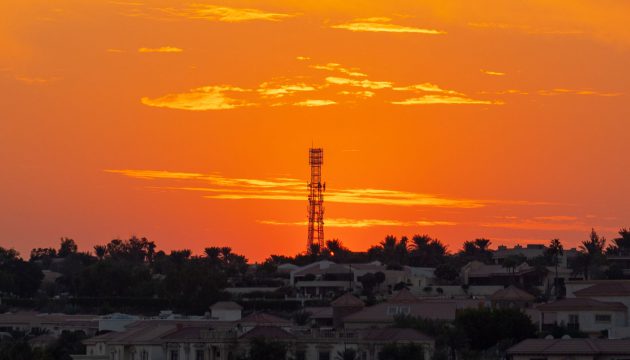In recent years, telecommunications providers have declared their intention to reduce greenhouse emissions substantially. With the ICT industry accounting for at least two percent of global energy consumption, there is political pressure and the will to make good on these promises. The continual expansion of and upgrades to mobile networks, including 5G, will however cause data and energy consumption to skyrocket in the coming years. Even though new radio equipment is more efficient per bit than legacy technologies, how can operators reduce emissions and costs as consumption continues to rise?
Site optimisation
Although most existing sites do have basic electricity meters that can report kWh consumed, the amount and type of data provided is very limited, even with so-called smart meters. No correlation of power consumption with environmental conditions such as temperature, sunlight, humidity, or windspeed is possible with these energy meters. Consequently, optimising energy consumption at such sites involves the costly step of visiting them and conducting a survey, keeping in mind the limitations of a one-time or snapshot survey.
Next, the operator may conduct a study and analyse the results. Due to varying environmental and other conditions (even from one site to the next), a study in one part of a country would not necessarily apply to other regions in which the provider operates. The effort and cost involved with this method can outweigh potential energy and cost-saving programs.
Missed opportunities
The last time mobile communications providers faced large-scale upgrades, equipment cost was an overriding factor in purchasing decisions. For instance, initial investment is lower if you purchase the same size solution for every site. Energy data management now allows network power designers to optimise the site power design in ways that were just too labour intensive in the past. With quick access to high-quality local energy data and environmental information, it’s now possible to optimise site-by-site. What’s more, this greatly simplifies planning for future requirements.
Energy data management is no longer the luxury item it was perceived to be in the past. Now, it’s becoming more of a necessity. Without granular data on environmental conditions and energy consumption, optimising for greater energy efficiency becomes extremely difficult. With radio base stations accounting for more than 60% of the energy a mobile operator consumes, this lack of data represents a considerable barrier to reducing emissions. Retrofitting the equipment needed to provide good data is possible without interruption to service, and in many cases can be close to a zero-cost action.
EDM enables optimisation decisions
Knowing power consumption alongside environmental conditions lets us identify the most suitable sites for energy-saving measures. We can look at the energy consumption of cooling systems in relation to the environmental conditions that battery and transmission equipment are operating in. This data can uncover optimised setpoints for base station cabinet cooling. Comparing cooling effectiveness across numerous sites is also possible. Or we can calculate power usage effectiveness (PUE), just like you would for a large data centre to keep KPI’s common across network verticals. The result of these analyses may suggest different cooling methods could be used. That might mean replacing air conditioning units with free cooling, for example.
A major network operator in Portugal, for instance, used monitoring alone to identify which sites in their network were not performing well. After implementing improvement plans, they reduced energy costs by an average 25% across 200 sites in the project. This confirms: even in “warmer countries,” not every site must necessarily have air conditioning and a one-size-fits-all approach can result in inefficiencies.
Network investments
Carriers are investing billions in 5G spectrum and network rollouts. One of the greatest challenges 5G presents is reducing emissions despite rapidly increasing data traffic.
With a very minimal investment of just a few hundred dollars per site, operators can install an advanced energy data management solution together with their 5G upgrades or 4G expansion. Since technicians will already be on-site, they don’t need to conduct an additional visit to retrofit the additional monitoring equipment, if needed. Once connected to iDEAn, Delta’s intelligent remote monitoring software, an EDM solution can result in as much as 25% OPEX savings through reduced energy consumption and optimised maintenance. This investment often pays for itself within as little as two years. Furthermore, the total savings are enormous when one considers the thousands of base stations throughout a network.
Minimising site visits and ensuring their success
You can’t send a technician up an icy tower. You also don’t want to cancel a site visit out of caution if there is in fact no ice. Remote monitoring also saves money by letting operators know when site visits are possible. Without certainty about environmental conditions, it is difficult to make the correct decision. With on-site sensor data, you can easily determine relevant and localised conditions in real time, eliminating the need to rely on slower and less accurate weather reports.
In addition, with real-world reports of up to 25% of call-outs labelled “no fault”, operators know when a site visit is really necessary while also providing technicians with a greater view of the issue before leaving for a site visit.
Delta’s energy data management also allows maintenance scheduling to be optimised based on equipment use rather than estimates or failures.
This reduces unnecessary maintenance while increasing network resilience by allowing urgent faults or maintenance to be handled faster.
Dispatching technicians with greater precision lets operators save up to $600 and 20kg CO2e (CO2 equivalent) for each site visit avoided.
Optimising battery installations
Many base stations already have batteries installed. Delta’s Managed Services let us know where additional energy storage will reduce costs and emissions the most. Base Stations may use spare capacity or add batteries for peak shaving, negative power reserve, or demand-side response; charging when energy prices are low and supplying power when prices on the grid are high. Energy storage is of course highly effective in combination with solar or wind energy. Over-dimensioned sites also reveal themselves with iDEAn, Delta’s energy management software, allowing excess batteries and rectifiers to go to other sites that need them more.
If you can’t measure it, you can’t improve it
The cost of retrofitting energy monitoring and connectivity equipment to existing sites, for instance once 5G upgrades have already been completed, is higher. That’s not an ideal situation, but even so, EDM still provides a relatively quick ROI even as a retrofit. Once monitoring is in place, future energy demands become far more manageable and less costly. Many departments benefit from having a sound energy management platform including operations, network design, supply chain, and more. Now, a network manager will be able to justify the procurement of power supplies that will meet projected needs not just for the next five years, but for the longer term — based on reliable, real-world data. That saves considerable unnecessary expenditures going forward, bringing future-proof site design a big step closer to reality.
When combined with other energy-saving solutions such as hybrid power systems, solar add-ons, and ultra-high-efficiency rectifiers, iDEAn is an indispensable tool for shielding operators from exposure to tightening environmental regulations and rising energy prices. Best of all, an EDM solution simply makes sense: for bottom lines, for the environment, and for the generations that will follow us.



